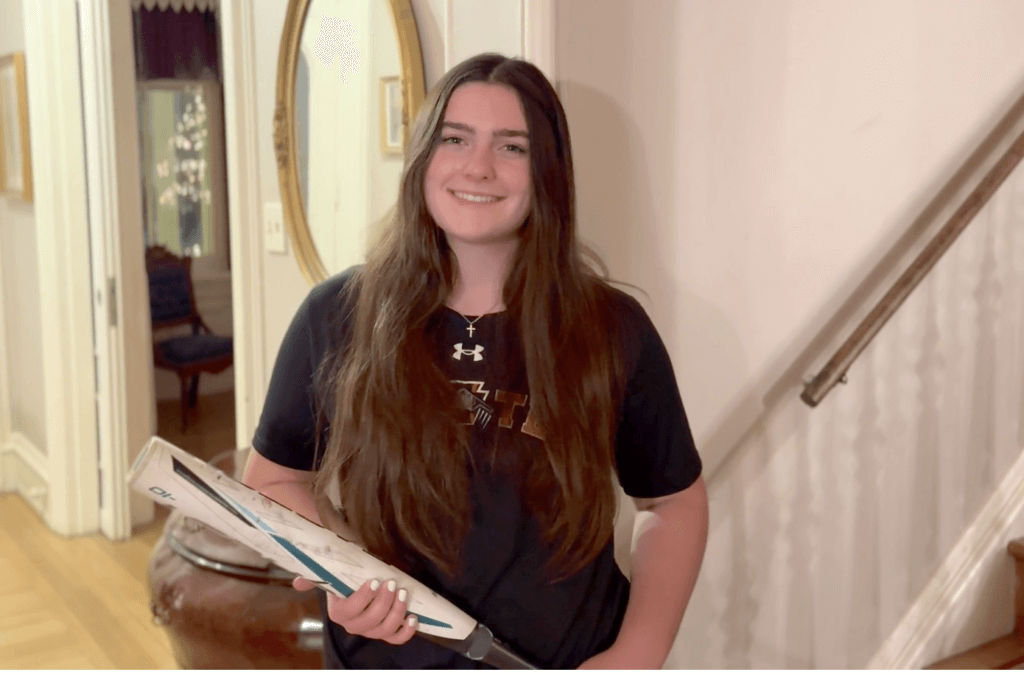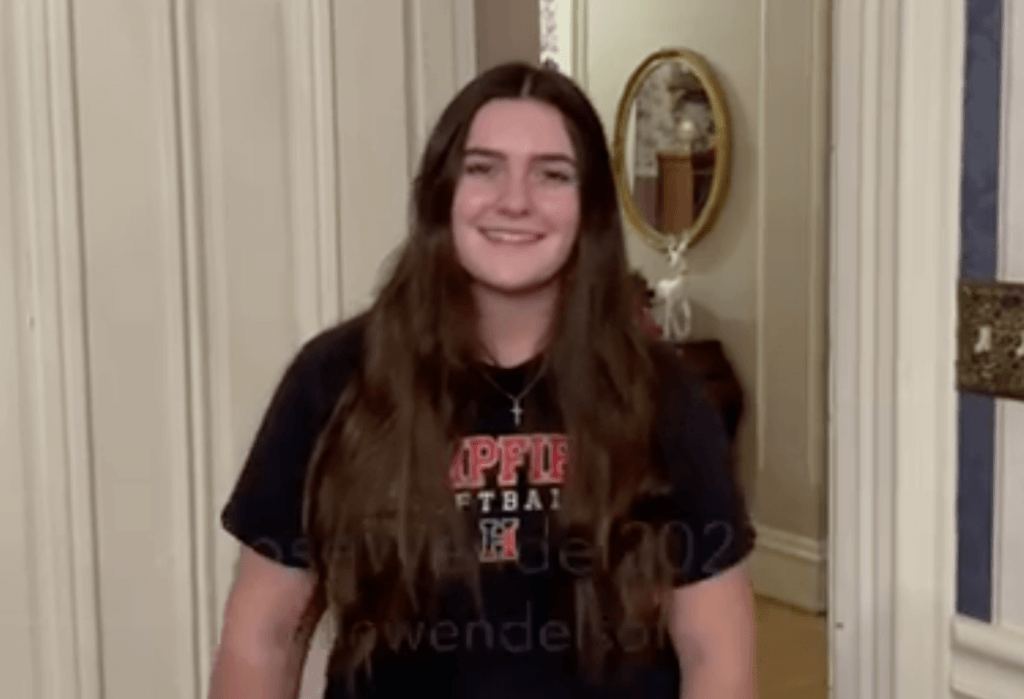
Extra Inning Softball continues our series of articles with record-setting college softball coach Mike Lotief who, after 17 years of coaching Louisiana Ragin’ Cajuns softball, reveals the training program that propelled his team to the NCAA tournament, the Women’s College World Series, and NCAA Super Regionals.
Keep checking in every Tuesday and Thursday to learn how, as Coach Lotief puts it, “to improve your swing and up your game!”
*****
Aleah’s solo home run in the 9th inning of the NCAA Lafayette Regional versus Texas A&M, snapped an 8-8 tie and proved to be the winning run that clinched the Cajuns 5th (fifth) consecutive Super Regional Appearance. (ON AN INSIDE PITCH).
Let’s take a look at Aleah hitting a grand slam on another INSIDE PITCH in the 2016 Sun Belt Tournament:
INSIDE PITCH.
OUTSIDE PITCH – OPPO.
This is a home run Aleah hit against Texas in 2018 after she transferred to Arizona for her senior season on an outside pitch.
Let’s break it down. At the outset, we are only interested in swing mechanics that can generate enough bat speed to hit the ball to the OPPOSITE FIELD WITH POWER.
SWING BREAKDOWN
Let’s look at 3 (three) side by side frames from each at bat and see if she adjusted the timing or tempo or amount of her pelvis loading for an inside versus an outside pitch.
- Aleah starts her pelvis load slightly after 12 o’clock so the first side-by-side will be at 9 o’clock in the pitcher’s delivery.
- At the pitcher’s release; Aleah has a good idea of whether the pitch is going to be INSIDE OR OUTSIDE. Horizontal ball movement is usually the easiest pitch characteristic for the fastpitch hitter to recognize. Between pitcher’s release and toe touch, is when the hitter decides to go from pelvis coil to rotation based on information collected.
- Aleah is at toe touch; she has definitely recognized inside versus outside – at this point, she is recognizing up versus down (vertical ball movement), and linear change of speeds. So, at this point, Aleah knows and has recognized that one pitch will be inside and the other will be outside.
And toe touch is a good landmark to use to assume that the pelvis has transitioned from coil to rotation and transferred its energy.
- At launch, Aleah’s pelvis is done and the second link of the kinetic chain (torso) is in motion, where more than likely, her barrel path adjustments will happen.
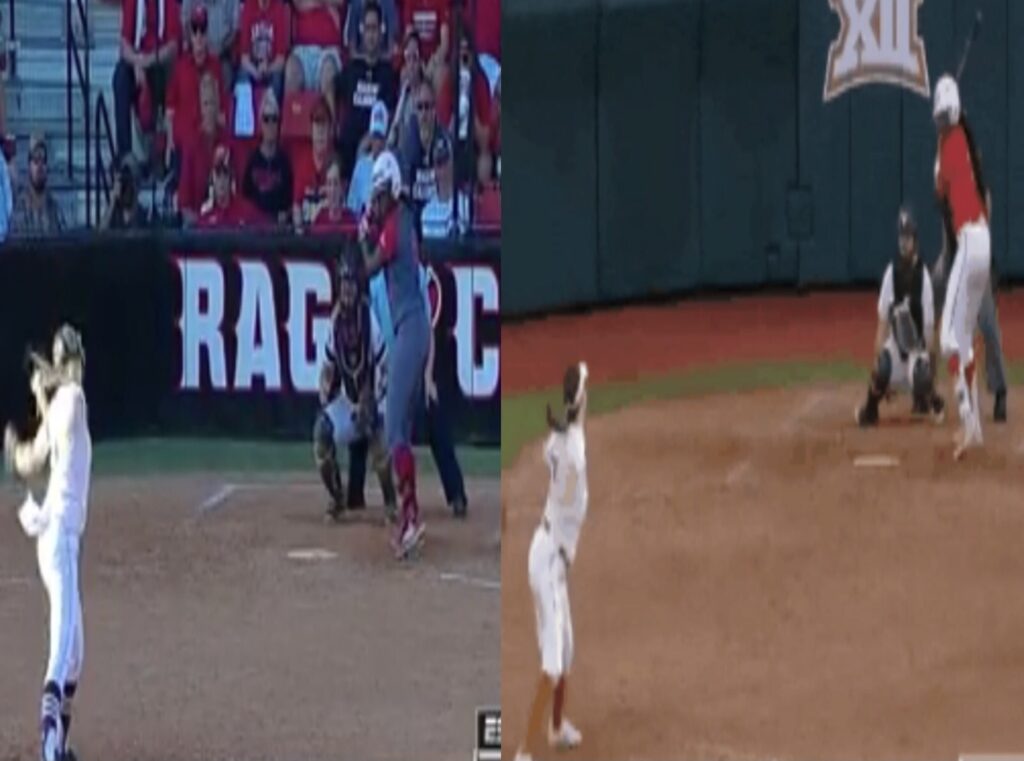
The pitcher is on her downswing past 12 o’clock and Aleah has already hinged her pelvis and starts her coil to increase the tension. Unless the pitcher has tipped the location, Aleah is in her normal pelvis load tempo.
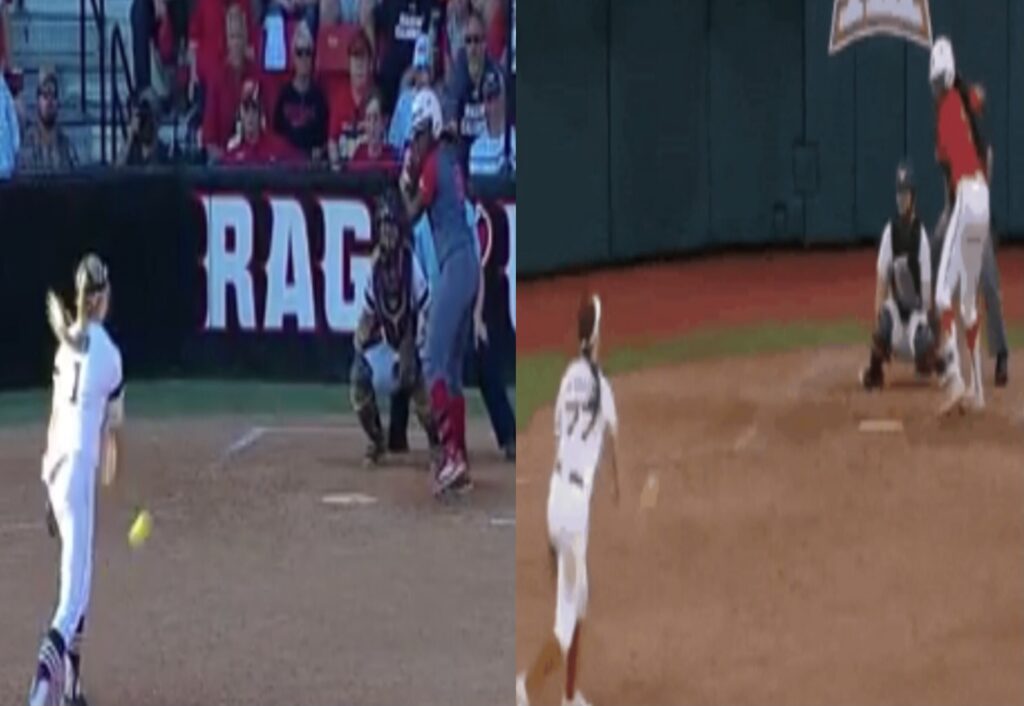
At pitcher’s release or slightly thereafter, Aleah “knows” whether the pitch is heading INSIDE (photo on the LEFT) OR OUTSIDE (photo on the RIGHT) but she maintains her pelvis coil as she starts to move her middle.
This is where lots of young hitters swings start to go bad because they have a tendency to want to hurry up and get their foot down or “step in the bucket,” especially if they are not confident and comfortable handling velocity on the inside half of the plate.
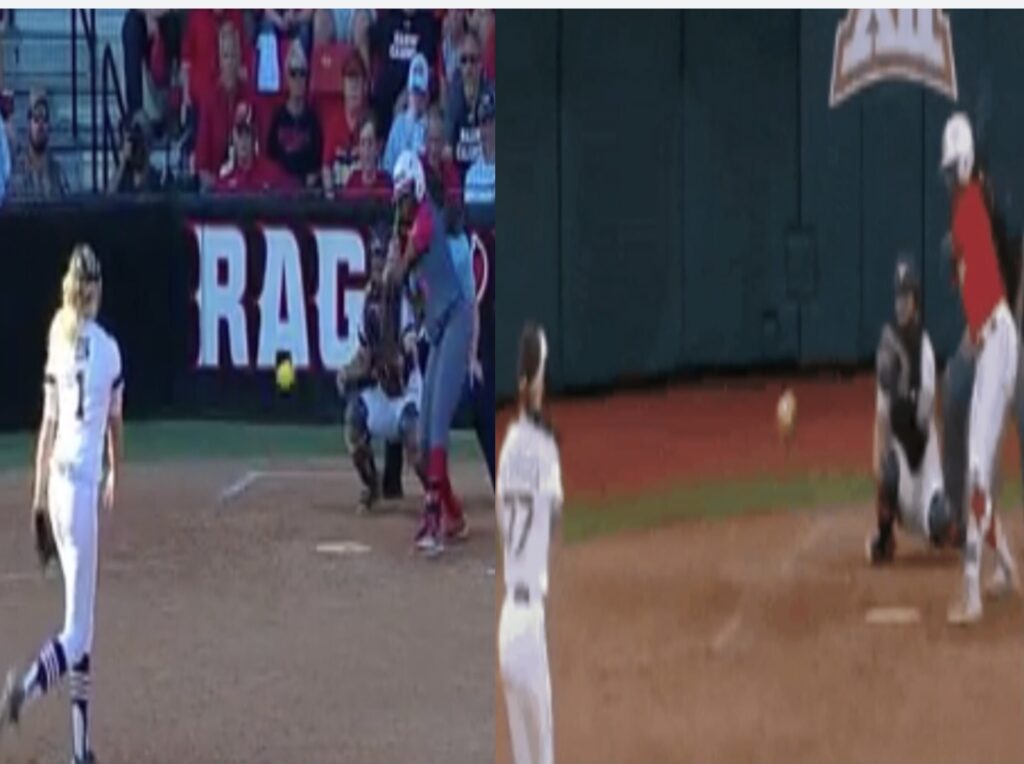
The pitch is approximately 12 feet away and Aleah has gotten to toe touch — a good spot to assume that her pelvis has rotated and transferred its energy. Notice that Aleah has the same posture on both the inside and outside pitch; she is not leaning over the plate.
The differences of the rotation of her pelvis are “slight” but OBVIOUS — noted by: (1) the positioning of her stride foot (but emphasis that this is NOT A LEG ACTION, IT IS AS A RESULT OF HER PELVIS ROTATION – proximal to distal) and (2) the location of her belt buckle: on the inside pitch (on the LEFT), more open and on the outside pitch (on the right), more closed.
What’s the mechanical adjustment?
Aleah’s major adjustments will be in the next three links of the kinetic chain – her torso, arms and barrel. You can already start to see some differences starting to occur. Good hitters recognize INSIDE VERSUS OUTSIDE early (soon after the pitcher’s release); if you want to hit both pitches with power, it is essential to “load,” “coil,” and “rotate” the pelvis.
HOW TO MAKE THE MOST OF REDSHIRTING
Aleah redshirted in 2014 and became an All-American in 2016 and 2017. Same exact script that Christi Orgeron followed: Christi redshirted in 2008 and was a two-time All-American in 2011 and 2012. (read about her journey by clicking HERE).
When All-Americans keep repeating themselves after redshirting, it’s not luck or pure coincidence!
What does redshirting mean and why do it?
- First of all, redshirting is NOT just sitting around shagging balls and waiting for next year and somebody to graduate so you can play.
- It’s not about playing time or depth charts at all. It’s about getting better!
- It is NOT about maintaining your “status quo” skill set. The reason you are redshirting is because your skill set must improve… especially your hitting.
Redshirting is about skill acquisition, using the time –the year of delayed eligibility—to get better, to work hard and practice and to use the resources and expertise of the coaching staff to improve your skills.
In order to do that, the athlete and the coach have to be willing to show up outside of “prime time” which is when the starters are getting their practice time in and require 100 percent of the resources and 100 percent of the coaching staff’s attention.
It is NOT hitting off of a tee either by yourself during prime time—it’s being creative and imaginative to find opportunities to get quality, game-like experience with the guidance and oversight of the coaches after hours.
Building a better movement pattern involves a lot of hard work and knowing about the use and application of “Attractors” (read article #1: What is a Swing Attractor?).
Skill acquisition by using the right “Attractors” is always the first step in the transformation. When to use what drills and/or which gadgets matters. Doing weekly assessments and prescribing individualized, specific functional movement protocols is critical.
Knowing when, where, and what to constrain and knowing how to manage the degrees of freedom issues is as much of an art as it is a science.

Teaching the Central Nervous System a totally different “rate of force development” requires specificity. Engraining it into her memory and learning a totally different data base and pitch recognition patterns took thousands and thousands of repetitions.
It takes lots of video & chalkboard discussions, simulated at bats, live scrimmaging, and lots of visualization/role playing/hypothetical scenarios, etc. “after hours”.
It’s hard work for the coach and the player, but if it is done right, it is so intrinsically fulfilling — and even years later when watching those home runs in magical moments, it still gives you chills and brings the biggest smile to your face.
AWARDS & HONORS
Aleah is ALWAYS a pleasure to be around with a great perspective!
Below is a listing of some of Aleah’s awards and honors while at UL for four years—from 2014 (redshirt) through 2017—before transferring to Arizona for her senior season (2018).
She was a PRE-MED MAJOR WITH HONORS and served on the Student Athletic Advisory Committee.
Aleah was also was recognized as the CONFERENCE’S FEMALE ATHLETE OF THE YEAR AS A JUNIOR (ALL SPORTS, ALL INSTITUTIONS) for her athletic and academic achievements and for her community involvement, leadership and taking a stand to make a difference.
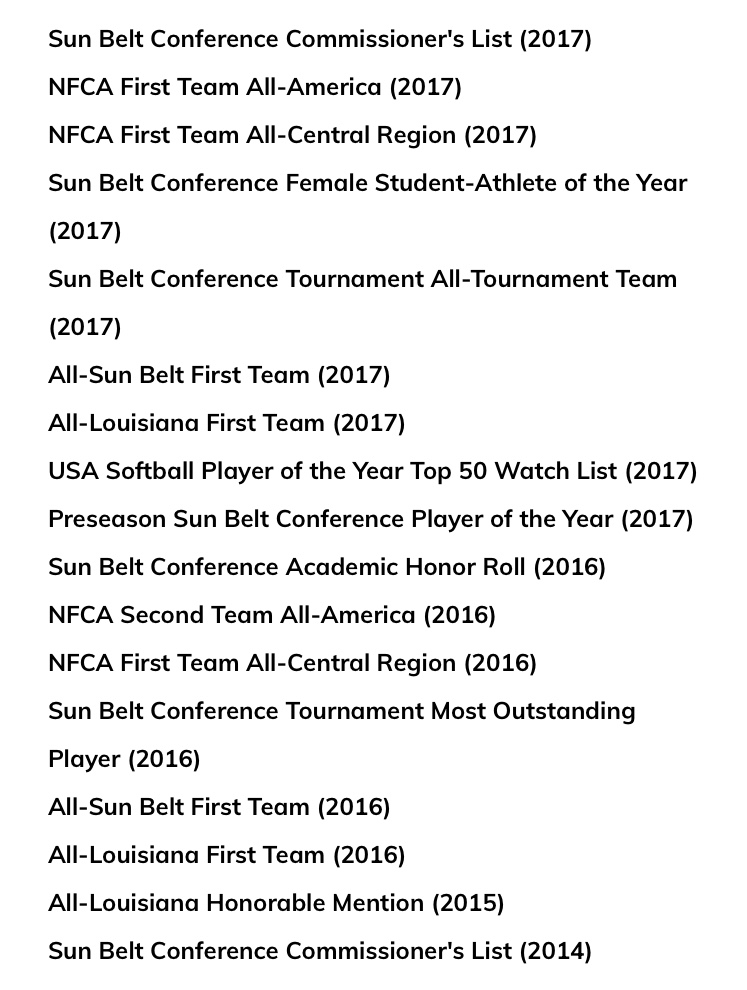

These are Aleah’s hitting statistics while at UL after redshirting her first year in 2014; she is a two time NFCA All-American center fielder in 2016 & 2017 for Coach Mike Lotief; she is from Priarieville, Louisiana and the daughter of Alonzo & Loretta Craighton.
This family is 100 percent committed to the process and the pursuit of EXCELLENCE! Aleah is still in graduate school pursuing medical degrees.
Be assured, that the experiences of college softball taught her to become a fierce competitor and a strong, confident woman… and will also guide her in MAKING A DIFFERENCE in her community and in the medical profession.
PURSUE EXCELLENCE & WIN THE NEXT PITCH!
About the Author
 Mike Lotief coached 17 successful years as either the head softball coach or co-head softball coach with his wife Stefni Whitton Lotief at the University of Louisiana from 2002-2017 with an overall coaching record of 731-176 (80.6 winning percentage). Every season, the Ragin Cajuns softball team advanced to the NCAA tournament and also advanced to three (3) Women’s College World Series (2003, 2008, 2014) and from 2012-2016 advanced to five (5) straight NCAA Super Regionals. Coach Lotief produced over 40 All American selections and his 2017 team lead the nation in scoring and was ranked in the Top 10 in home runs, slugging percentage, on base percentage.
Mike Lotief coached 17 successful years as either the head softball coach or co-head softball coach with his wife Stefni Whitton Lotief at the University of Louisiana from 2002-2017 with an overall coaching record of 731-176 (80.6 winning percentage). Every season, the Ragin Cajuns softball team advanced to the NCAA tournament and also advanced to three (3) Women’s College World Series (2003, 2008, 2014) and from 2012-2016 advanced to five (5) straight NCAA Super Regionals. Coach Lotief produced over 40 All American selections and his 2017 team lead the nation in scoring and was ranked in the Top 10 in home runs, slugging percentage, on base percentage.
The coach is a cancer survivor (twice) and was the first person in the U.S. to receive the Pro Trach device. Mike and Stefni spearheaded and raised the funding to build the new softball stadium in 2009 and the new softball indoor hitting facility in 2015. They are proud parents to Chelsea, who played softball and graduated from the Univ. of Louisiana in 2018, and Andrew, who is a junior at Louisiana studying Mechanical Engineering.
Previous Articles in this Series
- The Mental Swing Attractors: To Overcome Tough Times, It Takes Mental Toughness! (Dec. 2, 2021)
- Training Insights: “Swing Attractors” by Coach Mike Lotief… Vanessa Soto, Building “Oppo” Power in the Offseason (Nov. 30, 2021)
- Training Insights: “Swing Attractors” by Coach Mike Lotief… Shelbi Redfearn, Before & After Learning Pelvis Load (Nov. 23, 2021)
- The Mental Swing Attractors: Teamwork… Stand by Each Other (Nov. 18, 2021)
- Training Insights: “Swing Attractors” by Coach Mike Lotief… More Flaws of Pelvis Loading Continued (Nov. 16, 2021)
- The Mental Swing Attractors: Failure Cannot Break You (Nov. 11, 2021)
- Training Insights: “Swing Attractors” by Coach Mike Lotief… the Flaws of Pelvic Loading (Nov. 9, 2021)
- The Mental Swing Attractors: Push Yourself… You Don’t Have to Be #1 to BE #1! (Nov. 4, 2021)
- Training Insights: “Swing Attractors” by Coach Mike Lotief… Pelvis Loading, Part 2—The Planes of Movement (Nov. 2, 2021)
- The Mental Swing Attractors: Remove the Rope from Your Ankle & Get Rid of the Limiting Beliefs! (Oct. 28, 2021)
- Training Insights: “Swing Attractors” by Coach Mike Lotief… Pelvis Loading, Part 1—It’s All in the Hips (or Somewhere Deep Below) Oct. 26, 2021
- The Mental Swing Attractors: Champions are Developed by Devotion & Discipline! (Oct. 21, 2021)
- Training Expertise: “Swing Attractors”… the Secrets of Power Hitting by Coach Mike Lotief (Oct. 19, 2021)
More About Mike Lotief
- Why Michael Lotief is a Legendary Coach? by Jay Patel
- The Secret To Michael Lotief’s Success. By Jay Patel
- Michael Lotief Fights for Rajin’ Cajuns by Graham Hays ESPN
- Michael Lotief: Taking His Sport to New Heights by Neha Kapoor
- For the Love of the Game: A Look at Ragin’ Cajun Softball’s Power Couple
- How Louisiana-Lafayette’s Michael Lotief Develops Hitting Gems by Graham Hays ESPN



